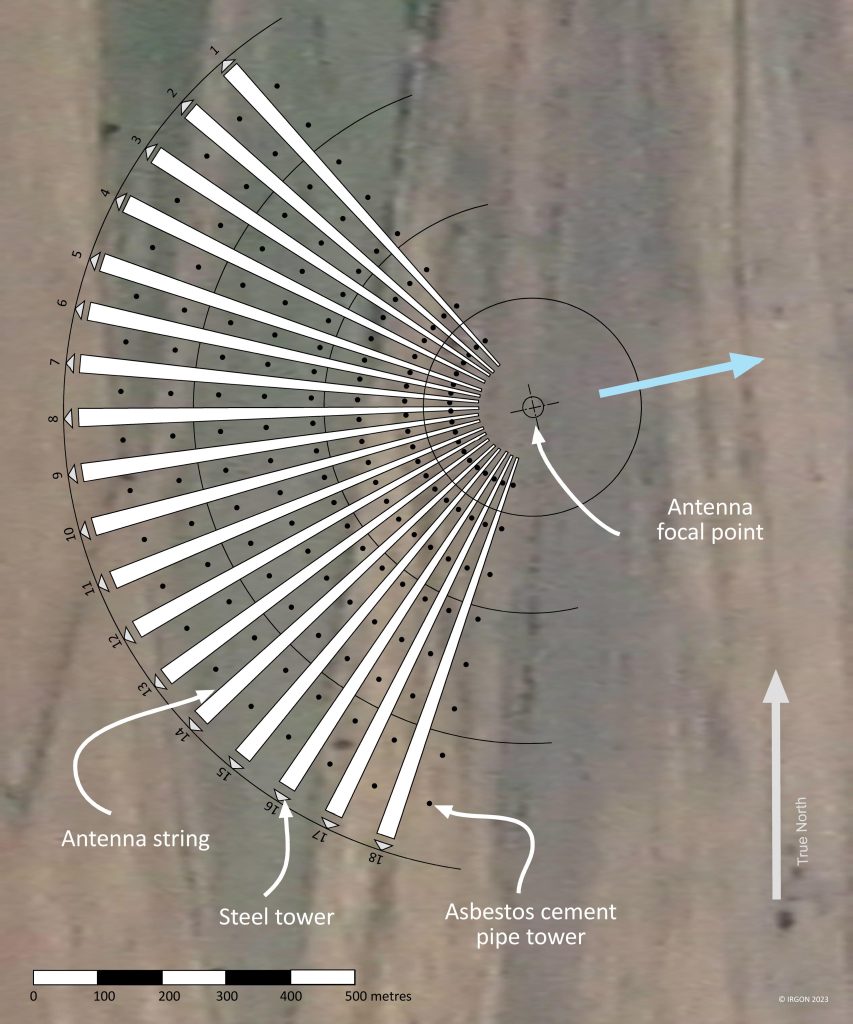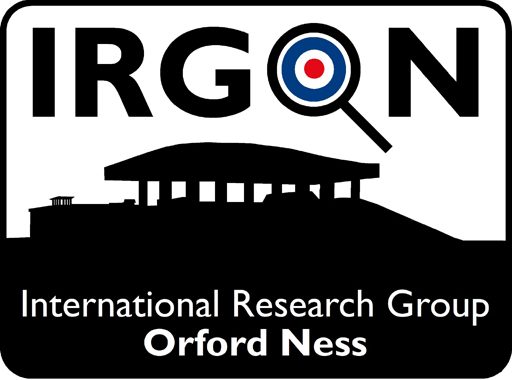
System 441A*, initially code-named SENTINEL FAN, later SENTINEL MIST, but better known by its final code name COBRA** MIST, was an over-the-horizon (OTH) radar built to overlook air and missile activity in Eastern Europe and the western areas of the USSR. There was originally a nuclear detection requirement, but this appears to have been dropped by the time the design had crystallised. 2

© Crown Copyright / National Archives 2022 Contains public sector information licensed under the Open Government Licence v3.0.
At the time, it was the most powerful and sophisticated radar of its kind, with the possible exception of the highly classified CHECKROTE system. 3
COBRA MIST was designed to utilise the world’s largest log-periodic antenna. 4 The construction of this aerial system, with 18 antenna strings supported on asbestos cement pipe towers, brought its own engineering problems.

Each antenna string was 670 metres long and carried both horizontal and vertical radiating dipoles. The strings were angled 7 degrees apart, creating a 119-degree sector of a circle. The complete antenna was constructed over a wire mesh screen, which extended beyond the strings in a seaward direction. Beam-forming was achieved by connecting six adjacent strings together. This was done by means of a switching arrangement situated underground at the hub of the antenna. Some complexity was introduced by the need to maintain a planar wavefront with the antenna geometry, this necessitated some phase shifting to be introduced into the outer strings of the active sextet. Some detailed photographs are available here: A COBRA MIST gallery.
Installation of COBRA MIST started on Orford Ness and test transmissions began in March 1971. Being a high-power radar theoretically able to develop peak RF power of 10 MW, a new power supply from the mainland had to be installed (refer to the IRGON article on electrical supplies to Orford Ness).
COBRA MIST was plagued with problems, the most serious of which was clutter-related noise. Refer to this separate article by an IRGON researcher on the attempts to overcome the noise problem. A usable operational status was never achieved, and COBRA MIST ceased operations as of 1730 Zulu time on 29th June 1973. 5
Calibration against airborne and ground-based reflectors
IRGON research has uncovered evidence of an extensive calibration programme for COBRA MIST. This began in the summer of 1971, and involved both ground-based and airborne calibration targets. The ground-based calibration meant installing passive antenna arrays in various overseas locations. An article is in preparation to explain the details of this effort. The airborne effort was done with specially equipped aircraft flying orbits and radial patterns around Orford Ness. IRGON research is continuing on this aspect.
COBRA MIST and ground-wave tests
In the early 1950s, the British carried out experiments with over the horizon detection of aircraft using ground waves. Working prototypes were built, but work was discontinued in 1953 when it was realised that such a system could be easily jammed. COBRA MIST’s parameters (frequency range of 6 to 40 MHz, vertical as well as horizontal radiating dipoles enabling vertical polarization, and a site looking out over water) made it suitable for ground wave propagation. By the 1970s it was considered worthwhile to carry out a new set of investigations to establish the value of ground wave propagation in the context of the state of the art of radar signal processing. These trials are the subject of further IRGON research.
What led to failure?
There is still much controversy around the failure of COBRA MIST, and there have been several articles written. To begin with, the AN/FPS-95 project had several hallmarks of a project management based on political, rather than technical parameters. This was compounded by a degree of inter-service rivalry between the US Navy and the USAF. Unwisely, in their bidding process the Air Force ignored the organisations who had already built successful OTH radar systems. This excluded groups like Raytheon Corporation, General Electric, the National Bureau of Standards, and ACF Industries, (by 1967 known as ITT Electro -Physics Laboratory) the builders of the AFTAC “R” system, otherwise known as CHAPLAIN.
Bizarrely, the Americans were already operating an OTHR with very similar operational characteristics to COBRA MIST in the Far East. This was CHECKROTE, a CIA sponsored OTH system developed by ACF Industries as a successor to CHAPLAIN/EARTHLING. However, the USAF rejected the bid made by ACF’s successor ITT Electro-Physics Lab; this company had conducted a rapid but detailed study of the specification, and concluded the design was flawed. This is not what the USAF wanted to hear, with the result that this tried and tested possibility was never taken up. 6
The main bugbear was the problem of clutter-related noise, and the root cause of this was never conclusively established. This in itself has led to a lot of speculation after COBRA MIST’s demise. Was it a result of design problems, or imperfect installation? (for example, although the transmitting and receiving components were shown to be relatively noise free, there were indications that the antenna, ground screen and RF hardware were contributing to the noise and some rework was carried out).
Or was there a more sinister reason behind the noise issue? To investigate this latter possibility, a study was conducted to determine if the noise problem could have been the result of deliberate jamming. The MITRE report concluded that a jamming system was technically possible, but evidence was never uncovered to confirm whether the Soviets had really implemented such a system. 7
The possibility of jamming aside, there were probably enough factors in the design and implementation of the COBRA MIST system to account for the issues encountered. Besides the antenna and hardware issues mentioned above, the signal chain and processing subsystems would have introduced problems of their own, and an official report stated “…it was also demonstrated that the data processing and display techniques used in the system constituted a more significant source of degradation in performance.” 8
In the final analysis, a combination of separate factors probably led to the abandonment of this complex and costly radar project in the summer of 1973.


The COBRA MIST site in 2022. © Richard Flagg / IRGON
*The USAF equipment name was AN/FPS-95. The name “System 441A” was assigned by the main contractor RCA and covered the radar itself plus all the downstream signal processing.
** “Cobra” is generally the first-word codename of programmes associated with US Air Force Intelligence collection efforts (there are some exceptions to this). 1
References
- The Boeing KC-135 Stratotanker, 3rd edition. Robert S. Hopkins III, Crécy Publishing Ltd., 2022
- COBRA MIST, RAF ORFORDNESS – Concept of Operations, Brief for the US of S (RAF) 22nd October 1971 (from AIR 2/18764, The National Archives via Anne Mallaband)
- The Wizards of Langley, Jeffrey T. Richelson, Westview Press Inc., 2002. CHECKROTE was a CIA sensor deployed against China. The agency became aware of COBRA MIST in the 1970s, but were less than impressed “… we were briefed on COBRA MIST on two occasions. In these briefings and subsequent discussions we could find no logical basis for establishment or continuation of this system” (Final Report of the Defence Science Board Task Force on tactical warning, February 1972, approved for release 2004/12/15 from cia.gov, via David Emery)
- World’s largest log-periodic antenna, Journal of the Structural Division, American Society of Civil Engineers, Yen H. Dong, September 1971, via Len Thomas
- FOI Request from Cufon, section 343. Department of the Air Force, Air Force Intelligence Command, 20th April 1993
- The Most Powerful and Sophisticated Over-the-Horizon Radar….., Ed Lyon, Radio Age, July 2019
- The Enigma of the AN/FPS-95 OTH Radar, E. N. Fowle, E. L. Key, R. I. Millar, AND R. H. Sear, The MITRE Corporation, Bedford, Mass
- Minutes of the 23rd meeting of the MoD advisory group on UK participation in OTHR systems and projects, 12th July 1973 (from AIR 8/2679, The National Archives via Anne Mallaband)
